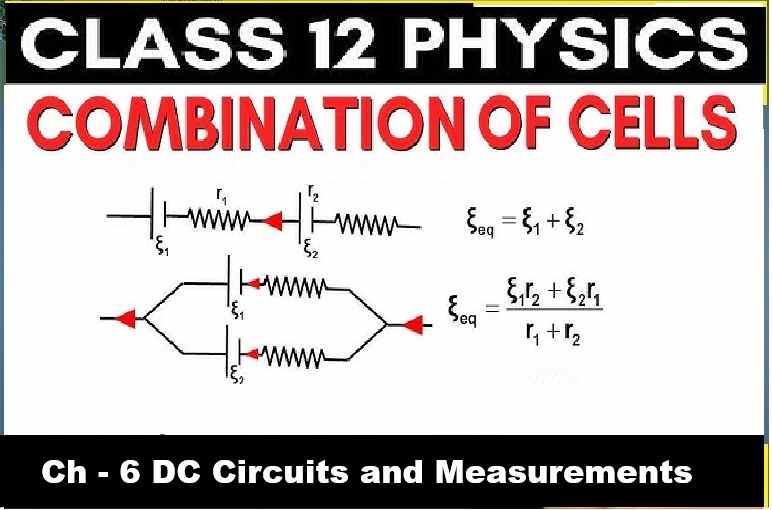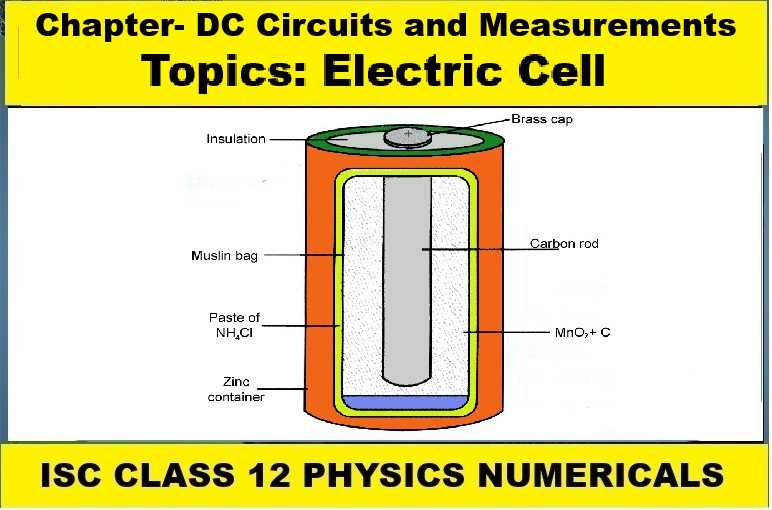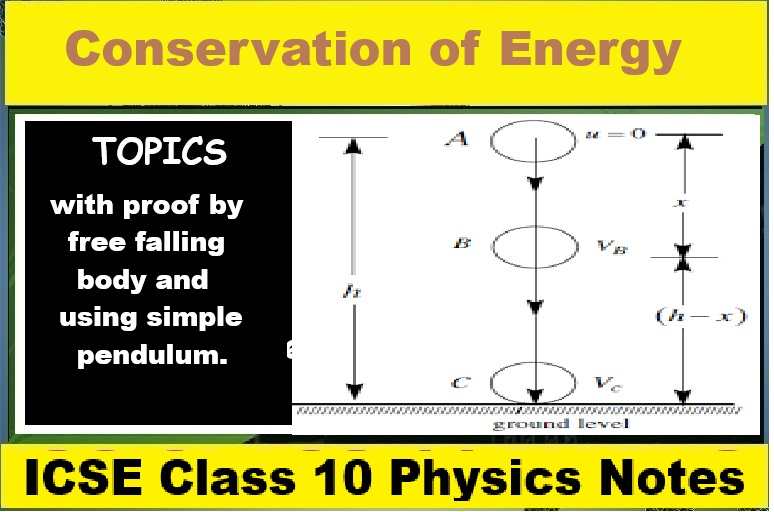Flower Goyal Brother Solutions ICSE Class-9 Biology Ch-4. We Provide Solutions of Exercise-4 The Flower Goyal Brother Prakashan ICSE Class-9 Ch-4. The solution contain All Type exercise question such as name the following, odd one, MCQs and figure based. Visit official Website CISCE for detail information about ICSE Board Class-9.
The Flower Goyal Brother Solutions ICSE Class-9 Ch-4
| Board | ICSE |
| Publications | Goyal Brother Prakashan |
| Subject | Biology |
| Class | 9th |
| Writer | Dr. S.K. Aggarwal |
| Chapter-4 | The Flower |
| Topics | Solutions of Exercises-4 |
| Edition | for 2022-2023 Academic Session |
Ch-4 The Flower Goyal Brother Prakashan ICSE Class-9 Biology Solutions
(Page-44)
Questions 1. Give the technical term for the following:
(i) Flower which contains all the four whorls.—-complete or perfect flower.
(ii) Male and female flowers on the same plant.—-hermaphroditic
(iii) Filaments united to form a single staminal tube.—-monadelphous stamens.
(iv) Axis bearing a group of flowers.—Peduncle‘
(v) Type of inflorescence in Jasmine.—cymose
Questions 2. Complete the following statements:
(i) A flower having both the reproductive organs is called ….bisexual..
(ii) In …. cymose … inflorescence, the main axis ends in a flower.
(iii) A unisexual flower that has only stamens is called ….Staminate flower…
(iv) A pistil which is composed of two carpels is called …Bicarpellary….
(v) Thalamus is the expanded part of ...pedicel…...
Questions 3. Given below are sets of five terms each. Rewrite the terms in correct order in a logical sequence beginning with the term that is underlined
(i) Petals, Ovule, Sepals, Ovary, Stamens.
Sepals Petals Stamens. Ovary Ovule
(ii) Anther lobes, Pollen grains, Male gametes, Filament, Pollen chambers.
Filament Anther lobes Pollen chambers. Pollen grains Male gametes
(iii) Thalamus, Style, Pedicel, Ovary, Stigma.
Pedicel, Thalamus Stigma. Style Ovary,
Questions 4. Give one example each of the following types or flowers:
(i) A plant with nectaries–sunflowers
(ii) Incomplete flower–gourds,
Questions 5. Define the following terms:
(i) Apocarpous gynoecium–Apocarpous gynoecium means the presence of more than one carpel and the carpels are separate or unfused. It is a primitive condition. The examples of Apocarpous gynoecium include -Strawberry and Buttercup
(ii) Syncarpous gynoecium–A syncarpous gynoecium is composed of two or more connate carpels. You can often tell that carpels are connate when several stigmas are present. The term “compound pistil” is equivalent to a “syncarpous gynoecium”
(iii) Pedicel–The pedicel is a stalk or stem that supports a single flower. It connects the single flower to the inflorescence. It is usually seen in pedicellate flowers (e.g., Rose).
(iv) Peduncle–The peduncle is the stalk of a flower or an inflorescence. When a flower is borne singly, the internode between the receptacle and the bract (the last leaf, often modified and usually smaller than the other leaves) is the peduncle.
Questions 6. Distinguish between the following:
(i) Complete and incomplete flower–Complete flowers contain four flower parts: petals, sepals, stamen, and pistil. Incomplete flowers are missing one or more of these four parts. It is possible for a perfect flower to be incomplete, but it is not possible for an imperfect flower to be complete
(ii) Polysepalous and Gamosepalous calyx–Gamosepalous refers to a flower that possesses a calyx, consisting of fused sepals. E.g. Hibiscus. Polysepalous refers to a flower that possesses a calyx, consisting of separate sepals.
(iii) Apocarpous and Syncarpous gynoecium.–The flowers with apocarpous ovaries have more than one carpel with free nature. The flowers which have syncarpous ovaries tend to have fused carpels. These free carpels constitute an aggregate of fruits.
(iv) Flower and Inflorescence–The main difference between flower inflorescence is that flower is a modified shoot, which serves as the reproductive organ of flowering plants whereas inflorescence is a group of flowers arranged on a floral axis. Flower and inflorescence are two structures produced by the sexual reproduction of flowering plants.
Questions 7. What do you mean by accessory and essential whorls? Mention their functions.
Answer : accessory whorls: sepals(calyx)–protection of reproductive inner part of flower. petals(carolla)– To attract bees, butterfly etc insects for transfer of pollen grains. Essential whorls: Gynocium (female reproductive part) — and Androcieum (male reproductive part)– both take part in sexual reproduction
Questions 8. What is a neuter flower? Give one example of such a flower.
Answer : When both sexes are absent from a flower or are non-functional , the flower is said to be neuter. Neuter flowers have undeveloped or nonfunctional sexual organs. They have pistils and stamens that are nonfunctional or absent. The flowers are androgynous and the plants reproduce asexually. ex- sunflower
Questions 9. Define inflorescence. Name the two types of inflorescences, along with examples.
Answer : The inflorescence is the manner in which the flowers are arranged on the flowering axis. During the flowering season, the vegetative apex of the stem gets converted into a floral meristem. Based on whether the floral axis continues to grow or end in a flower, the inflorescence is classified into racemose and cymose.
Questions 10. Make labelled drawings of (a) a stamen and (b) a pistil to show their various parts, and state the functions of each of the labelled parts.
Answer :
(a) a stamen
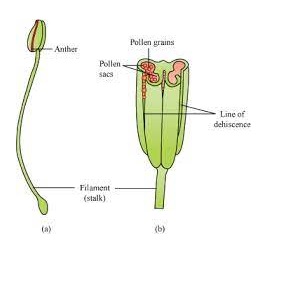
(b) a pistil
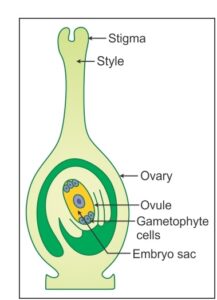
Questions 11. Look at the given picture and answer the questions:
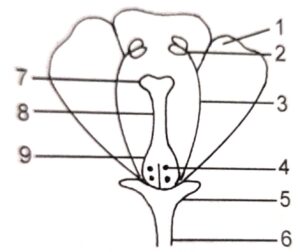
(i) Label the parts 1 to 9 in the figure shown below.
(ii) Whether the flower shown is unisexual or bisexual?
(iii) Give two plant names where such a flower is seen.
Answer :
(i) 1. petal, 2 anther, 3 filament, 4Ovule, 5 receptacle, 6 Pedicel, 7 stigma, 8 style, 9 ovary
(ii) bisexual?
(iii) Mustard, Gram
Questions 12. Observe the figure given below and answer the questions:
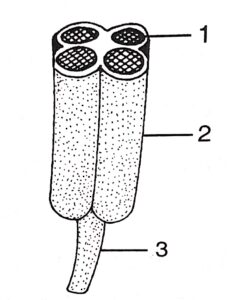
(i) Label the parts marked 1, 2 and 3.
(ii) Whether it is a male or a female organ?
(iii) What is the function of this organ in a flower?
Answer :
(i) 1 pollen chamber, 2 Anther and 3. filament
(ii) male organ?
(iii) Produce male gamete (pollen grains)
Questions 13. Observe the figures given below. These show two types of stamens. Name these types.

A shows ….Monodelphous…….. stamens.
B shows ….Didelphous….. stamens.
–: End of The Flower Goyal Brother Solutions ICSE Class-9 Biology :–
Return to:- ICSE Biology for Class 9 Goyal Brothers Prakashan solutions
thanks
